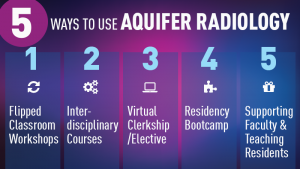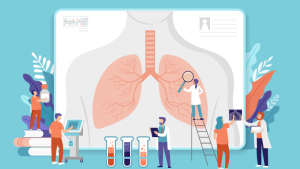Educator-to-Educator Tips & Strategies
Find out how your peers are making the most of Aquifer cases and teaching tools.
Find out how your peers are making the most of Aquifer cases and teaching tools.

By: Laurel Miller, PA-C | Assistant Professor – Directo … Read more

By: Youngjin Cho, Ph.D. (1), Jess Cunnick, Ph.D. (1), B … Read more

Aquifer cases are a staple assignment in many clinical … Read more

Whether you’re searching for ways to engage students in virtual learning, revamping a stale lecture, or building a new didactic session, flipping the classroom around Aquifer cases is a powerful way to engage your students and help case-based learning stick. Check out different ways that medical educators are integrating Aquifer cases into their pedagogy…

The 19 cases in Aquifer Radiology are designed to meet the needs of a wide range of learners and fit into many teaching modalities. Top radiology educators presented their successful strategies for integrating the cases in our recent webinar–find out what they shared…

The 27 cases in Aquifer Geriatrics are designed to meet the needs of a wide range of learners and fit into many teaching modalities. Top geriatrics educators from around the country presented their successful strategies for integrating the cases in our recent webinar–find out what they shared…

Diagnostic errors are a major source of morbidity and mortality in health care, and there is increasing focus on reducing diagnostic errors in medicine. Fitting these topics into your curriculum can be challenging. To help, I’d like to highlight strategies that educators have found successful using the cases and teaching tools included in Aquifer Diagnostic Excellence.

As the pandemic caused widespread disruption, Aquifer saw an unprecedented jump in the use of our cases–and many innovative ways to use the cases across curricula. Through our grant applications and many ongoing conversations with educators, we were able to identify trends and challenges and gather success stories and strategies to share.

This year, COVID added additional challenges to the difficult transition from pre-clinical to clinical/clerkship years by limiting student and faculty interactions during the traditional orientation week. We used Aquifer to create an online Orientation Course for our LIC students that addressed multiple key concepts and facets of the transition to the clinical/clerkship years and allowed our team to focus our limited in-person time on crucial activities.

Students provide consistently high rankings for Aquifer as reported in our five-star rating feedback data, but how and when cases are integrated into the curriculum can have a significant impact on their learning. Find out what themes emerged when we ask students what methods are most effective–and discover practical tips for assigning Aquifer cases based on student feedback.

We have integrated Aquifer Geriatrics cases in several different ways throughout our Geriatrics and Healthy Aging Curriculum thread. First-year students have a modified team-based learning session around the Dementia case. In the third year, cases prepare students for oral presentations on rounds…

When the COVID 19 pandemic interrupted our first-year medical students’ longitudinal primary care practicum (PCP), we needed to find an alternative that addressed one of its most important goals: helping students to focus the comprehensive history, exam, and documentation that they’re taught in the clinical skills course into a primary care-appropriate presentation and SOAP note. Our thoughts turned quickly to Aquifer, which is used by our internal medicine and pediatrics clerkships. Many Aquifer cases integrate well with the basic science topics our first-year courses, but most seemed a little too advanced for a mid-first year student. At the same time, senior students were eager to find ways to help, so we decided to combine Aquifer cases with ‘virtual’ peer teaching via videoconference.

If you want to use Aquifer cases as a clinical correlate in basic sciences classes just assign one case per week (e.g. pediatric case about cystic fibrosis in a genetics course; internal medicine case about anemia in hematology course). Students at UW have told me that this is about the right number of cases because the case content is complicated for early students. Students can work independently through the case and you can use it as context for discussion about how the basic science helps explain the clinical presentation–getting to the “why” behind how patients present as they do!
Notifications